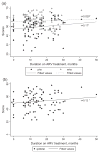Quality of life, psychosocial health, and antiretroviral therapy among HIV-positive women in Zimbabwe
- PMID: 20024731
- PMCID: PMC4431539
- DOI: 10.1080/09540120902923055
Quality of life, psychosocial health, and antiretroviral therapy among HIV-positive women in Zimbabwe
Abstract
Little is known about the psychosocial impact of antiretroviral therapy (ART) among women in sub-Saharan Africa. Therefore, we conducted a cross-sectional study in Zimbabwe to assess the impact of ART on HIV-positive women's health-related quality of life, using the Medical Outcomes Study-HIV Quality of Life (QOL) questionnaire. Additionally, we assessed socio-demographics, reproductive and sexual health, HIV-related history, disclosure, social stigma, self-esteem, and depression. Structured interviews were conducted with 200 HIV-positive women and categorized into three groups by treatment: (1) Group 1 (n=31) did not meet clinical or laboratory criteria to begin treatment; (2) Group 2 (n=73) was eligible to begin treatment but awaiting initiation of treatment; and (3) Group 3 (n=96) was on ART for a median of 13 months. The women had similar socio-demographic characteristics but varied significantly in clinical characteristics. Women on ART reported fewer AIDS-related symptoms in the last week and year and had higher current and lower baseline CD4 counts compared to women not on ART. On most QOL domains women on ART reported higher mean scores as compared to women not on ART (p<0.01). Additionally, women on ART reported less depression compared to women not on ART (p<0.001). Between the two groups of women not on ART, unexpectedly, there were no significant differences in their scores for QOL or depression. Thus, Zimbabwean women living with HIV experience better overall QOL and lower depression on ART. Altogether, our findings suggest that ART delivery in resource-poor communities can enhance overall QOL as well as psychosocial functioning, which has wide-ranging public health implications.
Figures



References
-
- Berger BE, Ferrans CE, Lashley FR. Measuring stigma in people with HIV: Psychometric assessment of the HIV stigma scale. Research in Nursing and Health. 2001;24(6):518–529. - PubMed
-
- Coates TJ, Grinstead OA, Gregorich SE, Sweat MD, Kamenga MC, Sangiwa G, et al. Efficacy of voluntary HIV-1 counselling and testing in individuals and couples in Kenya, Tanzania, and Trinidad: A randomised trial. Lancet. 2000;356(9224):103–112. - PubMed
-
- Department of Health and Human Services. Panel on antiretroviral guidelines for adults and adolescents. Guidelines for the use of antiretroviral agents in HIV-1- infected adults and adolescents. Panel on antiretroviral guidelines for adults and adolescents. Guidelines for the use of antiretroviral agents in HIV-1-infected adults and adolescents. 2008 http://www.aidsinfo.nih.gov/ContentFiles/AdultandAdolescentGL.pdf.
-
- Djomand G, Roels T, Ellerbrock T, Hanson D, Diomande F, Monga B, et al. Virologic and immunologic outcomes and programmatic challenges of an antiretroviral treatment pilot project in Abidjan, Cote d’Ivoire. AIDS. 2003;17(Suppl 3):S5–S15. - PubMed
-
- Ichikawa M, Natpratan C. Perceived social environment and quality of life among people living with HIV/AIDS in northern Thailand. AIDS Care. 2006;18(2):128–132. - PubMed
Publication types
MeSH terms
Substances
Grants and funding
LinkOut - more resources
Full Text Sources
Medical
Research Materials
